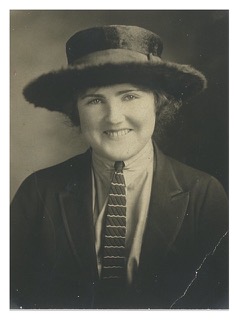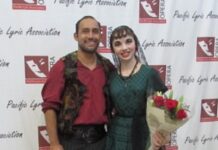El Cajon, when Marilyn Allen first moved there in 1957, was more rural than it is today, but it was nowhere near as rural as the river canyons in Idaho and Oregon where her aunt taught school during the first quarter of the 20th century.
Allen’s aunt, Katherine Wonn Harris, wrote a book on her experience teaching the children of ranchers. Allen has republished that book called Topping Out, which is the term the locals used for reaching a distant and difficult goal.
“I wanted to share her stories with the world,” Allen said.
The details in the book may or may not be what actually occurred.
“She was a good storyteller and she could have embellished it because of her writing experience,” Allen said.
In the book Harris noted that she had changed the names of the people she encountered. The book only covered her first year of teaching, and she stated that she taught for seven years.
“She may have taught in a lot of different schools,” Allen said.
The specifics of teaching in such a remote location wasn’t the focus of Harris’ book. She noted that life was tough in the river canyons, and to some extent how the ranch families—and Harris while she was teaching school there—lived was a focus of Topping Out. That same austerity also meant that the natural beauty of the area was for the most part unspoiled by civilization, so her descriptions of the geographic features and wildlife also superseded the emphasis on what specifically happened.
“She was always tied into the primitive life because she valued it so much,” Allen said.
“Her heart and soul was in that Snake River and Salmon River and Hell’s Canyon,” Allen said. “I think that was very important to her that she could always go back to that life and she knew how to live it.”
According to her autobiography Harris spent her early childhood in a rural part of Idaho before her mother had the family relocated to Boise for more convenient schooling. “When she talked about her early life in Boise it was barren,” Allen said. “There wasn’t the beauty.”
Harris was born in December 1899 based on what the family knows. “She lied about her age to get the job, so we never knew for sure,” Allen said.
Allen was born in 1939 and thus knew her aunt. “She lived in San Diego. During World War II she worked at Convair,” Allen said. “She was a women’s counselor.”
Allen’s mother was born in San Diego. Harris lived in the North Park area of San Diego during World War II, as did Allen. “I was just a little girl,” Allen said.
After the war ended Harris and her husband moved to Lebanon, Oregon, while Allen moved to the Talmadge area of San Diego.
Allen’s family moved from Talmadge to El Cajon during the second semester of Allen’s senior year at Hoover High School, although she made the trip for the final weeks and graduated from Hoover before attending San Diego Junior College (now San Diego City College), UCLA, and San Diego State College.
Approximately 800 students were in Allen’s 1957 graduating class at Hoover High School. “That was the biggest class they ever had, because they built Crawford right after that,” she said.
No enrollment numbers for Harris’ first teaching position were provided, but her summer session had seven pupils of various ages.
After Allen married she lived in the Allied Gardens and Del Cerro areas of San Diego, but after her parents passed away she moved into their house in 2006 and has lived in El Cajon ever since.
Traveling to more rural areas was also part of Harris’ life in Lebanon. “She took us up to Mount Angel,” Allen said. “That was one of her favorite places to go.”
The epilogue of Topping Out noted that Harris made two visits to the river canyon areas after she was no longer teaching there. “Both of those trips were really important to her,” Allen said.
The first of those trips was in 1956 when Harris and her husband flew over the area in their plane. Harris was able to view the entire land from the air but could not identify where she had lived or taught. “She really did a lot of research and she really did try to find where she had been when she started there and couldn’t find much evidence,” Allen said.
The other trip was in 1970 when she visited the Salmon and Snake rivers from the ground to investigate rumors of development. Harris found that the canyons were preserved while some bridges had replaced the ferries of the earlier era, and she began advocating for the preservation of the rivers themselves.
When Harris was alive Allen didn’t discuss her aunt’s teaching career. “We didn’t talk about the old days,” Allen said. “I was just happy to be with her when I was with her.”
Topping Out was published in 1971. Harris’ will caused Allen to republish the book. “She named me as her publisher, so I figured I’d better get busy,” Allen said.
Allen made some changes from the original version. She removed the segment about her aunt rolling her own cigarettes. “I was hoping to make it a book for young people,” Allen said. “I wanted it to be wholesome and I wanted it to be for children to read.”
The prologue in the current version had been part of an interior chapter. The prologue notes that the era of seasonal ranches would end shortly after Harris began teaching and mentions several possible factors including the discontent the women had for the harsh, austere, and nomadic lifestyle.
“She had all these different types of women: the woman who wanted to get away, the women who were just toughing it out, and her friends back in the city,” Allen said.
Balboa Press, which is a division of Hay House, published Topping Out.














